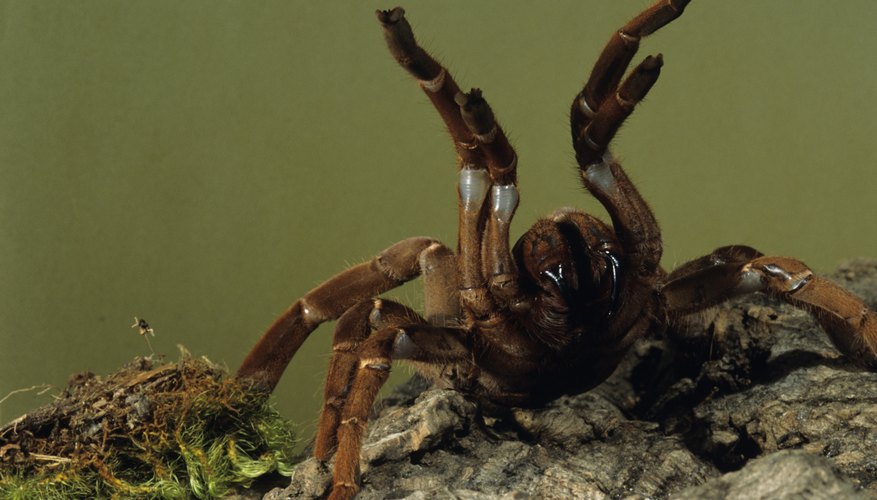Large and hairy, tarantulas feature in many scary spider stories, but these remarkable animals pose little threat to people and are fascinating examples of how species adapt to their environments. Most tarantulas belong to the family Theraphosidae and include more than 1,400 species. In their mainly forest habitats, tarantulas have evolved anatomies and behaviour different from most spiders.
Anatomy
Tarantula anatomy is adapted so that they survive through hunting prey rather than catching it in webs. The largest of all spider species, and among the largest and longest lived of animals without a backbone, tarantuals weigh between 28 to 100 grams (1 to 3 ounces). The largest known tarantula, the goliath bird-eating spider (Theraphosa blondi) has a 28 cm (11 inch) leg span. Many tarantulas are also well-camouflaged in their forest environments, their bodies covered in brown and black hairs. Some spiders, such as the Mexican red-kneed tarantula, are more colourful.
- Tarantula anatomy is adapted so that they survive through hunting prey rather than catching it in webs.
- The largest known tarantula, the goliath bird-eating spider (Theraphosa blondi) has a 28 cm (11 inch) leg span.
Feeding
Tarantulas have evolved venom and powerful fangs to paralyse, digest and eat their prey. Feeding on frogs, small lizards, snakes, amphibians, large insects, rodents and, rarely, small birds, tarantulas first paralyse their prey by injecting venom with their long fangs. As well as immobilising the victim, the venom digests its tissues, breaking them down into a soup which the tarantula can then draw in. Alternatively, tarantulas can also crush their prey with their powerful jaws. They are nocturnal hunters.
- Tarantulas have evolved venom and powerful fangs to paralyse, digest and eat their prey.
- Feeding on frogs, small lizards, snakes, amphibians, large insects, rodents and, rarely, small birds, tarantulas first paralyse their prey by injecting venom with their long fangs.
Silk
Tarantulas don't spin webs, but they create silk to line their burrows, make cocoons for their eggs, create mats to lie on as they moult, and possibly help them grip as they walk. Easily injured in falls due to their large size, it's important that a tarantula's grip is secure. Similar to many spiders, they have tiny hairs on their feet that help them walk across vertical surfaces, but scientists speculated that tarantulas might also produce sticky silk from their feet to enhance their grip. Claire Rind and other scientists at the University of Newcastle found evidence from experiments in 2006 that suggests this is the case.
- Tarantulas don't spin webs, but they create silk to line their burrows, make cocoons for their eggs, create mats to lie on as they moult, and possibly help them grip as they walk.
- Similar to many spiders, they have tiny hairs on their feet that help them walk across vertical surfaces, but scientists speculated that tarantulas might also produce sticky silk from their feet to enhance their grip.
Defences
Despite their scary appearance, tarantulas rarely hurt people, biting only when severely threatened and injecting venom equivalent to a bee sting. Yet they have several defence mechanisms to help protect them from predators. Asian and African tarantulas' react to a threat by rearing up on their hinds legs and exposing their fangs. Other species have barbed, irritating hairs on their abdomens that they scrape off to flick at their enemies, lodging in eyes and mucous membranes and causing discomfort and blindness. Other tarantulas turn away from their attackers and squirt an unpleasant liquid in their faces.
- Despite their scary appearance, tarantulas rarely hurt people, biting only when severely threatened and injecting venom equivalent to a bee sting.
- Other species have barbed, irritating hairs on their abdomens that they scrape off to flick at their enemies, lodging in eyes and mucous membranes and causing discomfort and blindness.
